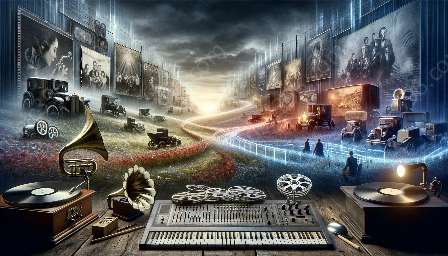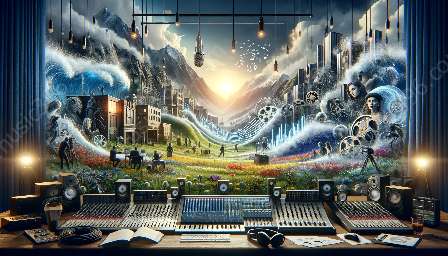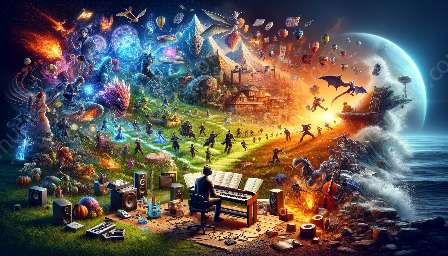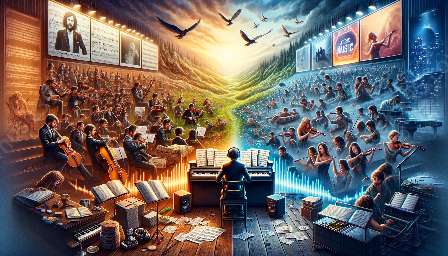Storytelling has always been a powerful means of conveying emotional and psychological depth, and soundtracks play a significant role in enhancing the audience's experience and understanding of the narrative. In this article, we'll delve into the fascinating world of soundtracks, exploring how they can be used to represent and explore psychological and emotional states in storytelling.
The Role of Soundtracks in Storytelling
Before we embark on our exploration of soundtracks in storytelling, let's take a moment to understand the fundamental role they play in shaping the narrative. Soundtracks are meticulously crafted compositions that accompany visual content, such as films, TV shows, video games, and stage productions. They serve to enhance the emotional impact of the story, create atmosphere and mood, and guide the audience's emotional journey throughout the narrative.
Engaging the Audience on an Emotional Level
One of the primary functions of a soundtrack is to engage the audience on an emotional level, heightening their involvement in the story. Through the use of carefully selected musical themes, tones, and rhythms, soundtracks can elicit a wide range of emotions, from joy and excitement to fear and sorrow. By manipulating the audience's emotional responses, soundtracks become a powerful tool for storytellers to convey psychological and emotional states within the narrative.
Connecting with Characters and Themes
Soundtracks have the ability to establish a deep connection between the audience and the characters and themes within a story. By creating musical motifs and leitmotifs associated with specific characters, events, or emotions, composers can reinforce the audience's understanding of the psychological and emotional states of the characters. This connection strengthens the audience's empathy and investment in the narrative, enriching their experience of the story.
Enhancing Suspense and Tension
Another vital aspect of soundtracks in storytelling is their ability to heighten suspense and tension. Through the use of dissonant chords, unpredictable rhythms, and escalating crescendos, soundtracks create an atmosphere of unease and anticipation, reflecting the psychological states of the characters and driving the narrative forward. The strategic placement of sound cues can intensify the audience's emotional engagement and suspense, leading to a more immersive storytelling experience.
Representing and Exploring Psychological and Emotional States
Now, let's focus on the intricate ways in which soundtracks can be used to represent and explore psychological and emotional states within storytelling:
Emotional Resonance and Impact
Soundtracks have the capacity to evoke emotional resonance and impact by aligning with the psychological states of the characters. The use of specific musical motifs, dynamics, and instrumentation enables composers to convey the complexities of emotional experiences, such as love, grief, longing, and triumph. As the soundtrack mirrors the characters' emotional journeys, it fosters a deeper understanding and empathy from the audience.
Character Development and Internal Conflict
Soundtracks play a crucial role in depicting character development and internal conflict by mirroring their psychological states through music. Subtle variations in the musical themes associated with a character can reflect their evolving emotional landscape, providing insight into their internal struggles, desires, and transformations. The soundtrack becomes a mirror of the characters' psychological complexity, enriching the storytelling and deepening the audience's connection to the characters.
Symbolism and Metaphor through Music
Through the skillful use of musical symbolism and metaphor, soundtracks can encapsulate deeper psychological and emotional meanings within the narrative. Composers infuse the music with symbolic elements that represent abstract concepts, psychological states, or thematic motifs, creating a multi-layered storytelling experience. This symbolic musical language serves as a powerful tool to explore and convey the intricate psychological and emotional undercurrents of the story.
Building Narrative Arcs and Climaxes
Soundtracks contribute significantly to the construction of narrative arcs and climaxes by dynamically representing the fluctuating psychological and emotional states of the characters and the story. Through the manipulation of musical tension, release, and catharsis, soundtracks guide the audience through the emotional peaks and valleys of the narrative, heightening the impact of pivotal moments and resolutions. The synthesis of sound and storytelling becomes a mesmerizing journey that immerses the audience in the psychological and emotional tapestry of the narrative.
Enriching the Storytelling Experience
As we conclude our exploration, it's evident that soundtracks are indispensable in enriching the storytelling experience and unveiling the intricate psychological and emotional layers of a narrative. By carefully orchestrating the music to reflect the characters' psychological states, thematic elements, and narrative contours, composers elevate the audience's engagement and comprehension of the story. Through the alignment of sound and storytelling, soundtracks provide a compelling platform for representing and exploring the profound psychological and emotional depths of human experience.





















